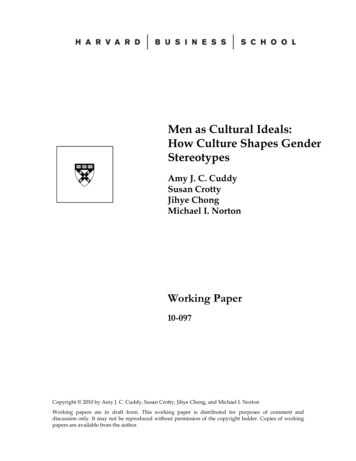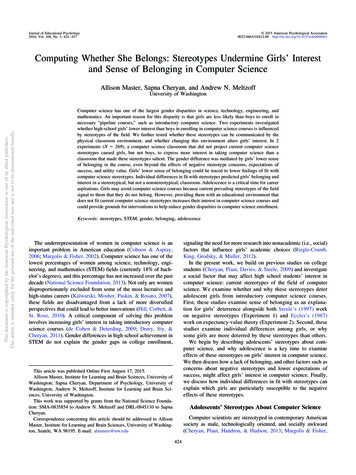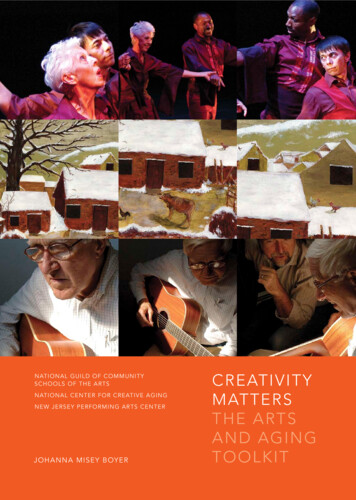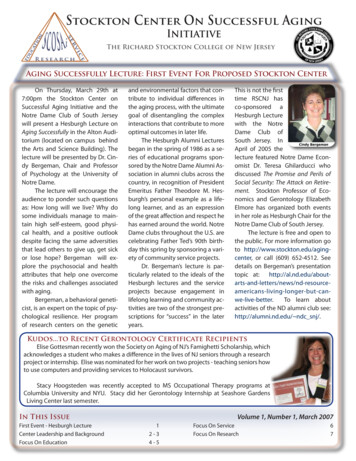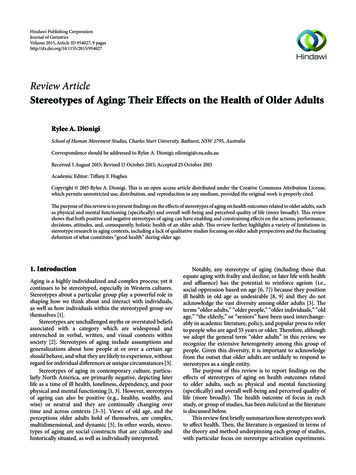
Transcription
Hindawi Publishing CorporationJournal of GeriatricsVolume 2015, Article ID 954027, 9 pageshttp://dx.doi.org/10.1155/2015/954027Review ArticleStereotypes of Aging: Their Effects on the Health of Older AdultsRylee A. DionigiSchool of Human Movement Studies, Charles Sturt University, Bathurst, NSW 2795, AustraliaCorrespondence should be addressed to Rylee A. Dionigi; rdionigi@csu.edu.auReceived 5 August 2015; Revised 13 October 2015; Accepted 25 October 2015Academic Editor: Tiffany F. HughesCopyright 2015 Rylee A. Dionigi. This is an open access article distributed under the Creative Commons Attribution License,which permits unrestricted use, distribution, and reproduction in any medium, provided the original work is properly cited.The purpose of this review is to present findings on the effects of stereotypes of aging on health outcomes related to older adults, suchas physical and mental functioning (specifically) and overall well-being and perceived quality of life (more broadly). This reviewshows that both positive and negative stereotypes of aging can have enabling and constraining effects on the actions, performance,decisions, attitudes, and, consequently, holistic health of an older adult. This review further highlights a variety of limitations instereotype research in aging contexts, including a lack of qualitative studies focusing on older adult perspectives and the fluctuatingdefinition of what constitutes “good health” during older age.1. IntroductionAging is a highly individualized and complex process; yet itcontinues to be stereotyped, especially in Western cultures.Stereotypes about a particular group play a powerful role inshaping how we think about and interact with individuals,as well as how individuals within the stereotyped group seethemselves [1].Stereotypes are unchallenged myths or overstated beliefsassociated with a category which are widespread andentrenched in verbal, written, and visual contexts withinsociety [2]. Stereotypes of aging include assumptions andgeneralizations about how people at or over a certain ageshould behave, and what they are likely to experience, withoutregard for individual differences or unique circumstances [3].Stereotypes of aging in contemporary culture, particularly North America, are primarily negative, depicting laterlife as a time of ill health, loneliness, dependency, and poorphysical and mental functioning [1, 3]. However, stereotypesof ageing can also be positive (e.g., healthy, wealthy, andwise) or neutral and they are continually changing overtime and across contexts [3–5]. Views of old age, and theperceptions older adults hold of themselves, are complex,multidimensional, and dynamic [5]. In other words, stereotypes of aging are social constructs that are culturally andhistorically situated, as well as individually interpreted.Notably, any stereotype of aging (including those thatequate aging with frailty and decline, or later life with healthand affluence) has the potential to reinforce ageism (i.e.,social oppression based on age [6, 7]) because they positionill health in old age as undesirable [8, 9] and they do notacknowledge the vast diversity among older adults [3]. Theterms “older adults,” “older people,” “older individuals,” “oldage,” “the elderly,” or “seniors” have been used interchangeably in academic literature, policy, and popular press to referto people who are aged 55 years or older. Therefore, althoughwe adopt the general term “older adults” in this review, werecognize the extensive heterogeneity among this group ofpeople. Given this diversity, it is important to acknowledgefrom the outset that older adults are unlikely to respond tostereotypes as a single entity.The purpose of this review is to report findings on theeffects of stereotypes of aging on health outcomes relatedto older adults, such as physical and mental functioning(specifically) and overall well-being and perceived quality oflife (more broadly). The health outcome of focus in eachstudy, or group of studies, has been italicized as the literatureis discussed below.This review first briefly summarizes how stereotypes workto affect health. Then, the literature is organized in terms ofthe theory and method underpinning each group of studies,with particular focus on stereotype activation experiments.
2The initial discussion will focus primarily (although notexclusively) on the effect of negative stereotypes, while thelatter will focus on the effects of positive stereotypes. In doingso, this review highlights that both positive and negativestereotypes of aging can simultaneously have enabling andconstraining effects on the actions, performance, decisions,attitudes, and, consequently, holistic health of an older adult.This review will also highlight a variety of limitationsin stereotype research in aging contexts, including a lack ofqualitative studies focusing on older adult perspectives andthe fluctuating definition of what constitutes “good health”during older age. Increasing our awareness of the multipleeffects of stereotypes on individual health outcomes in olderadults, and the assumptions embedded in research findings,can promote changes in individual and societal attitudes andbehaviors, as well as policy and professional infrastructuresthat benefit older adults.2. How Stereotypes Work to Affect HealthWhile physical and cognitive declines in later life can beexplained in physiological terms, psychosocial and sociocultural factors also play a key role in this process. Research inmainstream gerontology and psychology has demonstratedthe effects of stereotypes of aging on the health of olderpeople; however, the mechanisms by which this occursis constantly debated within and across disciplines [10–13]. Researchers have identified numerous theories of howstereotypes of aging impact older adults, primarily internalization/stereotype embodiment, stereotype threat, downwardsocial comparison/resilience, and (more recently) stereotypeboost and upward social comparison/role models [14–16].Given the range of theories used to explain how stereotypeswork to affect health, knowing which theory is driving eachstudy is necessary so that their findings can be clearly understood.Within these frameworks, experimental studies involving stereotype activation have shown that both implicit(subtle/subconscious) and explicit (conscious) negative agestereotyping can have similar detrimental effects on the performance of older people in physical and mental tasks [16, 17].In 2012, Meisner [17] conducted a meta-analysis to comparethe strength of positive versus negative age stereotypingeffects on behavioral outcomes in older adults. He found,regardless of the type of prime awareness, discipline of study,method, or participant group, that negative age primingelicited a stronger effect (of almost three times larger) onthe performance of older individuals during physical andmental tasks than did positive age priming [17]. However, amajor limitation of this analysis was that most of the studiesincluded in the review came from Levy’s lab. Other reviews,such as Hess et al. [18], found that research on implicitstereotypes has shown that emphasizing positive stereotypesand images of aging can weaken the negative influences ofa situation on the behavior of older adults. For example,Hess et al. [19] compared implicit and explicit priming ofaging stereotypes on older adults’ memory performanceand found that those primed implicitly showed significantdifferences in memory, with positive primes showing greaterJournal of Geriatricsrecall than negative primes. To highlight the heightened effectof domain-specific stereotypes on cognitive and physicaloutcomes in older adults, Levy and Leifheit-Limson [20,page 230] found that when the age stereotype matched theoutcome domain there was a stronger effect on performance,suggesting that when stereotype matching occurs “it is morelikely to generate expectations that become self-fulfillingprophecies.” They called this the stereotype-matching effect[20, 21].To complicate and extend these findings, however, otherstudies have shown that explicit positive aging stereotypescan have constraining effects on older people’s attitudes andhealth behavior and that negative aging stereotypes can beresisted by older adults resulting in enabling effects suchas feelings of personal empowerment and associated healthbenefits [8, 15, 22, 23].Notably, studies on the effects of stereotypes on the healthof older individuals typically define health in old age in termsof biomedical and psychosocial models of “successful aging,”with indicators of “good health” including low levels (orabsence) of disease and disease-related disability, high levelsof physical and cognitive functioning, continued social andactive engagement in life, and overall contentment, mentalhealth, and the ability to adjust to changes [8]. Nevertheless,the definition of what constitutes “good health” in olderage varies across studies. Collectively, research on this topichighlights the complexity in effects of stereotypes on thehealth of older individuals; there is no conventional patternas to how stereotypes are internalized into self-stereotypesand/or perceptions of oneself as an older adult, nor themechanisms underlying this process.3. Effects of Negative StereotypesMost studies on stereotypes of aging focus on the constraining effects of negative stereotypes for an older adult’shealth and ways to minimize/counteract these effects [1].The findings from stereotype activation experiments andlongitudinal studies have been useful in this regard [24].3.1. Stereotype Activation and Longitudinal Studies3.1.1. Implicit Priming of Stereotypes of Aging (and Stereotype Embodiment/Internalization). Results from numerousexperimental studies conducted by Levy and colleagues totest memory, hand writing skills, and walking ability indicatedthat subliminal exposure to negative age stereotypes cannegatively affect (or lead to no changes in) performance inthese domains in older adults, while implicit priming withpositive stereotypes of aging (such as wise and sage) tendedto improve performance [25–27]. For example, in Levy’sinnovative 1996 study, it was shown that older adults whowere implicitly primed with negative aging stereotype words(e.g., senile, dependent, and incompetent) and then asked toundertake memory tasks performed worse than the positivelyprimed group, regardless of age, gender, level of education,previous computer use, mood, and location of residence [27].Also, Levy et al. [28] and Levy et al. [29] found that aging selfstereotypes had a direct impact on physiological function,
Journal of Geriatricswith negative aging stereotype (subliminal) primes increasingcardiovascular stress in white and African American olderindividuals, respectively, before and after mental challenges,such as word and math tests.Moreover, the influence of stereotypes of aging on thehealth of older individuals can vary across cultures. Forexample, using a cross-cultural approach, Levy and Langer[30] conducted a comparative study and found that Americanhearing older adults held the least positive views of the agingprocess when compared to American deaf older adults andChinese older adults. Accordingly, the American hearinggroup performed the worst in memory tasks, followed by theAmerican deaf, and the Chinese group performed the best.However, Yoon et al. [31] did not replicate these findings intheir study of Chinese Canadians and Anglophone Canadiansbecause the differences in memory were specific to particulartypes of memory tests. They also did not conclude that therelationship between culture and aging was mediated bypositive attitudes about aging. In spite of these differences,both Levy and Langer and Yoon studies found smaller age differences in those groups who held more positive beliefs aboutaging. While cross-cultural research regarding stereotypeshas shown more positive stereotypes are held in Europeanand Asian cultures, this research has also highlighted thatthe same number and contexts of negative age stereotypes(i.e., cognitive incompetence) exist in these cultures, similarto Western cultures [32].Building on Levy’s body of work, numerous studies haveshown that implicit priming of negative age stereotypes canhave adverse effects on physical and cognitive functioning.For example, Auman et al. [33] found stereotype relatedincreases in anxiety, skin conductance, and blood pressureamong a sample of middle-aged and older men with hypertension (at an outpatient program) when the prime focusedon sickness, helplessness, and dependence. A key findingfrom this study was that the fear of being perceived as sick(as described in the negative stereotype prime) could actuallydiscourage people from seeking medical assistance, indicatingthat the concept of stereotype threat (discussed below) isworking in conjunction with the internalization of negativestereotypes. In contrast to Levy’s [27] findings, however, Steinet al. [34] found that priming with a positive age stereotypedid not improve memory performance for a group of olderadults. Stein et al. used a photo recall task and a dot locationtask to measure the memory performance of 60 older adultsbefore and after they were implicitly primed with a negativeage stereotype, a positive age stereotype, or neutral primes.It was found that memory performance was underminedamong those older adults who were negatively primed andunaware of the primes.In addition to these short-term effects on performance,Levy et al. [35] showed that aging self-stereotypes caninfluence older individuals’ will-to-live. In this study onresponses to hypothetical medical situations, older adultswho were subconsciously exposed to negative stereotypeprimes were less likely to accept medical treatment that couldprolong their life. In 2006, Levy et al. [36] examined theage stereotypes of 546 community dwelling adults aged 70–96 years and found that those who held more negative and3externally (i.e., physical appearance)-related age stereotypesshowed greatest hearing loss 36 months after the initial test.Although this study did not use implicit priming, the authorsspeculated that such findings could have health-behaviorconsequences, such as older adults not seeking assistance fromhealth professionals due to their belief that hearing loss is anormal and inevitable part of the aging process [36].Finally, given the limitations of controlled settings in theabove studies, more recent research by Levy and colleaguesaimed to determine if everyday encounters with negativestereotypes across one’s lifetime are associated with cognitiveoutcomes [37]. They found that, over a 38-year period,individuals with more negative age stereotypes showed significantly worse memory performance compared to thosewho held less negative age stereotypes and emphasized therobust impact self-relevance has on the effects of stereotypes[37]. This finding supports the view that because olderadults are often exposed to negative stereotyping, througheveryday interactions in the community and health caresettings, this constant exposure may serve as a negative primewhich can activate internalized negative age stereotypes[38]. To understand how these internal mechanisms operatealongside external factors in the environment, researchershave drawn on stereotype threat theory with a focus on theeffects of explicitly activating negative stereotypes of aging.Stereotype threat theory proposes that presenting familiarnegative stereotypes associated with a certain group threatensthis group into a scenario where they fear reaffirming thesenegative depictions [39–42].3.1.2. Explicit Priming of Stereotypes of Aging (and StereotypeThreat). Studies using explicit (rather than implicit) primingtechniques have found mostly similar (yet some conflicting) effects of aging stereotypes on physical and cognitiveperformance, as shown below. Most studies underpinned bystereotype threat theory have examined memory or cognitiveperformance of older adults [12]. The relationship betweenstereotype threat and regressions in memory performancehas been found among older adults who were explicitlyprimed with a negative stereotype (in the way the taskwas framed) [43–45], especially among those who weregreatly invested in their memory ability or had high levelsof education [46–48]. Stereotype threat has also been foundto worsen older adults’ math performance [49] and generalcognitive ability [50].A meta-analysis by Horton and colleagues [16] on theimpact of stereotype threat on older adults’ performance onmemory tasks found an overall weighted effect size (i.e., themagnitude of change due to experimental manipulation) of0.38 (with those exposed to negative stereotype primes in thestudies reviewed performing the worst on tasks). However,Horton et al. [16] acknowledged that their review did notinclude unpublished studies, such as master and doctoraltheses, and they cite two such studies that did not find aneffect on cognitive performance among older adults exposedto stereotype threat.A more recent meta-analysis of age-based stereotypethreat and effects on performance among older people (average 69.5 years) by Lamont et al. [51] included 22 published and
410 unpublished articles. They found a significant, yet smallto-medium, effect size of 0.28 (with older adults, regardlessof age and gender, memory and cognitive performance werenegatively affected by age-based stereotype threat). Lamontet al. also revealed that older adults were less affected byage-based stereotype threat when fact-based (rather thanstereotype-based) manipulations are used (𝑑 0.52) andwhen performance is tested using cognitive (rather thanphysical) tasks (𝑑 0.36). The inclusion of unpublished studies in this review allowed for a comprehensive analysis ofage-based stereotype threat effects which stresses that thisthreat is a real problem which older people face, especiallywithin formal test contexts. Also, Hess et al. [19], in theircomparison of the effects of implicit and explicit primingof aging stereotypes, found that with subtle (as opposed tohighly obvious) explicit primes older adults were able to offsetthe impact of negative stereotypes on memory performance,indicating a type of resilience to the effect of negative stereotypes on performance (a finding that supports resiliencetheory, discussed below).Scholl and Sabat [52] argue that to decrease the impactof stereotype threat individuals need to experience a sense ofperceived control over the situation which can be achievedby giving older individuals autonomy over personal decisionsregarding their health, aiding in the development of moreinternal health locus of control and motivation to seek outpreventative health measures. In addition, given the findingthat the effect of stereotype threat (and the associated levelof anxiety) is heightened when a person is being tested in adomain where their ability in that area is deeply important tothem, “it is vital that practitioners have in-depth knowledgeof their clients so as to understand which of their attributesare, and always have been, valued greatly” [52, page 123].In terms of broader health outcomes related to stereotypethreat, Coudin and Alexopoulos [53] examined the effectsof explicit negative stereotype activation (i.e., reading a text)on French older adults’ self-reported loneliness, risk-taking,subjective health, and help-seeking behavior and found thatsuch activation had harmful effects on participants’ selfevaluation and functioning, which may consequently leadto increased dependency. This study highlighted the role ofinterpersonal and situational factors for inducing dependency among older adults. In support, Burgess et al. [39, pageS169] argued that “by recognizing and understanding thefactors that can trigger stereotype threat and understandingits consequences in medical settings, providers can preventit from occurring or ameliorate its consequences for patientbehavior and outcomes.”In addition to these short-term performance effects ofexplicit negative stereotyping, repeated exposure to stereotype threat can result in disengagement from domains thatare perceived as threatening to one’s self-esteem, which inthe longer term can lead to disidentifcation (i.e., avoiding anyactivities that may result in reaffirming negative stereotypes)[1, 53]. In the case of older adults, this may involve removingthemselves from physical and mental activities because they“no longer view the domain as central to their identity and, asa result, stop expending effort in this domain [39, page S169],”which can have a negative effect on their holistic health [54].Journal of GeriatricsOn the other hand (and in line with the Hess et al. [19]study cited above), Horton et al. [40] suggested that someolder adults may not be affected by negative stereotypes.This study tested 99 older adults on six dependent measures, namely, memory recall, reaction time, grip strength,flexibility, walking speed, and self-concept. The findingsindicated that older adults were affected by the stereotypeintervention, but “they suffered no performance decrementson the main dependent measures [40, page 353].” With regardto memory performance, these findings contrast the metaanalysis performed previously by Horton et al. [16] detailedabove. Horton et al. [40] note that the specific nature of theparticipants in their 2010 study (healthy, well educated, andliving in a popular retirement locality in Canada) highlightsthe possibility that certain older adults may be resistant tothe potential threat of negative stereotypes of aging. This studyshowed the importance of understanding how individualolder adults respond differently to stereotypes, as well as howthey individually perceive their own aging.3.2. Downward Social Comparison (and Resilience Theory).From a sociological and qualitative perspective, Dionigi andcolleagues have found downward social comparison to betypical amongst highly active older adults. Older athletes tendto express a very negative perception of old age or “other”older adults, despite having positive self-perceptions of theirown aging [4]. Highly active older adults have been shownto express a desire to maintain physical and mental activityto avoid becoming “old” as they stereotypically understandit (i.e., frail, dependent on others, and diseased) [4, 8]. Onone hand, this finding represents an active resistance to agingstereotypes, which can be personally empowering, but onthe other hand it reinforces ageism and the individual (andcultural) fear of ill health in old age by positioning ill healthin old age as undesirable or irrational, rather than a naturalprocess [4, 23].From a psychosocial perspective, when explaining theacquisition of self-stereotypes of aging, Levy [55] describesthe above as the process of identifying oneself as “old” andargues that the more negative the aging stereotypes one holds,the more resistant one is to accepting themselves as old.This resistance could be a form of denial of the physiologicalrealities of the aging process, which could be maladaptive tooverall health and a sense of identity in later life [4, 56]. Theimportant message here is that there is much diversity andcomplexity in older adults’ perceptions and internalization ofaging stereotypes, which can affect an individual’s health inmultiple ways [15].3.3. Emerging Qualitative Research Findings. Qualitativeresearch findings highlight the complexity inherent in trying to make sense of multidimensional concepts such asperceptions and stereotypes of aging. For example, researchby Dionigi et al. [8] found that Canadian women aged 75years and over who were not physically active expressed morepositive attitudes towards their own aging and the term “old”compared to the women in the sample who were highlyphysically active. In other words, even though these womenheld high expectations and positive views of their own aging
Journal of Geriatricsand positive stereotypes of old age, it did not mean they weremore likely to engage in preventative health behaviors, such asphysical activity, in later life. Recently, there has been a call fora more culturally relevant, domain-specific, gender-specific,multidirectional, and multidimensional perspective of agingexperiences, feelings, and perceptions [5, 24, 57–60]. Withregard to gender differences, a quantitative study by Schaferand Shippee [58] found that feeling older led to more negativeviews about cognitive aging among women, but not men, aged55 years and over. More studies on differences between menand women with regard to the effects of stereotypes on healthoutcomes are needed.In 2014, Miche et al. [24] used an open-ended, diaryapproach with 225 men and women (aged 70–88 years) aboutage-related experiences. They highlighted that content-based,social-cognitive, and social-emotional age-related changeswere more important for participants’ overall well-being thanfunctional age-related changes. Similarly, a review by Diehlet al. [57] argued that long term health benefits among olderpeople will only be reached if individuals are given theopportunity to take active control of their own lives anddevelop a clear understanding of their aging process. Diehlet al. developed a conceptual model that allows researchersto create individual need profiles that can be used for intervention and translational research targeting optimal health inlater life. These findings question the emphasis in gerontologyon the relationship between functional ability and health inlater life. They highlight the need to broaden understandingsof what constitutes health in old age with particular emphasison how older individuals define “good health” and “successfulaging” in their terms [8].4. Effects of Positive StereotypesWhile it has been shown that implicit and explicit activationof negative age stereotypes can negatively impact older adults’short-term performance in physical and cognitive domains,and potential long-term health outcomes (i.e., health-relatedbehaviors), the effects of positive stereotypes of aging appearmore complicated and are comparatively underresearched.The following review will focus on findings that have emergedfrom experimental studies primarily related to the effects ofpositive stereotypes of aging on the health of older adults.4.1. Implicit Priming of Positive Stereotypes of Aging (andInternalization). Preliminary evidence suggests that implicitpositive stereotype primes can improve performance inolder individuals [16]. For example, many of Levy andcolleagues’ implicit priming studies reviewed in previoussections revealed that the positively primed group improvedtheir performance in the task being measured, such asmemory [19, 27], swing time, and balance speed associated withwalking [25], or had no change in their performance afterbeing primed, such as a muted cardiovascular response to cognitive challenges [28]. The latter finding led to the assumptionthat positive primes may act as a buffer to the effects ofnegative stereotypes [28].In addition, Levy et al. [35] found in their hypothetical will-to-live study that those who were exposed to5positive aging stereotypes were more likely to accept thelife-prolonging medical intervention. However, in contrastto Levy’s findings on memory [27], it was mentioned earlierthat Stein et al. [34] found that older individual’s memoryperformance did not improve after they were primed witha positive age stereotype. Therefore, it cannot be assumedthat implicit positive primes will always lead to improvedperformance in older adults. Nevertheless, researchers havebegun to examine if experimentally making people feelyounger will result in improvements in physical and mentalperformance.4.2. Explicit Priming of Positive Stereotypes of Aging (andStereotype Boost). Experimental studies on the potential forstereotype boost effects with older adults emerged in 2013.Swift et al. [61] examined the performance of older adultsin a domain where they are stereotyped more favorably thanyounger people (via crossword puzzles). They found that,compared with the control condition, the enhancing socialcomparison boosted performance among the older adults[61].Although explicitly making people feel favorable compared to younger people in experimental studies has shownshort-term improvements in physical [62] and cognitive [61]tasks, respectively, longer-term effects of explicit positivestereotypes in the daily lives of older adults (such as mediamessages depicting “healthy, active, and happy” older people)and the effects of dominant “successful aging” discourses(found in academic literature and popular press) are less wellknown. Making upward, rather than downward, social comparisons has multiple likely effects on the health behaviors ofolder individuals [63].4.3. Upward Social Comparison and Role Models. Emergingrole model research pertaining to older adults has highlightedthe multiple enabling and constraining effects of upwardsocial comparisons on older adults’ attitudes and healthrelated behaviors [15, 63, 64]. On the one hand, upward socialcomparisons, such as comparison with authentic older peoplewho are active and healthy, highlight what is possible in laterlife which can motivate individuals to become more activethemselves and counteract the development of negative selfstereotypes of aging [3]. For example, for already moderatelyactive older adults, older sportspeople may inspire them tobecome even more active [15, 63, 65].On the other hand, if highly active, healthy older peopleare perceived as unrealistic representations of what is likely inlater life, such representations can intimidate others, producefeelings of guilt and anxiety amongst older adults who cannotor do not want to meet that standard, and discourage peoplefrom engaging in certain health-related behaviors [3, 64, 65].For instance, Kotter-Grühn and Hess [22] provided evidencefor
social comparison/resilience, and (more recently) stereotype boost and upward social comparison/role models [ ]. Given the range of theories used to explain how stereotypes work to ae ct health, knowing which theory is driving each studyisnecessarysothattheir ndingscanbeclearlyunder-stood. Within these frameworks, experimental studies involv-

